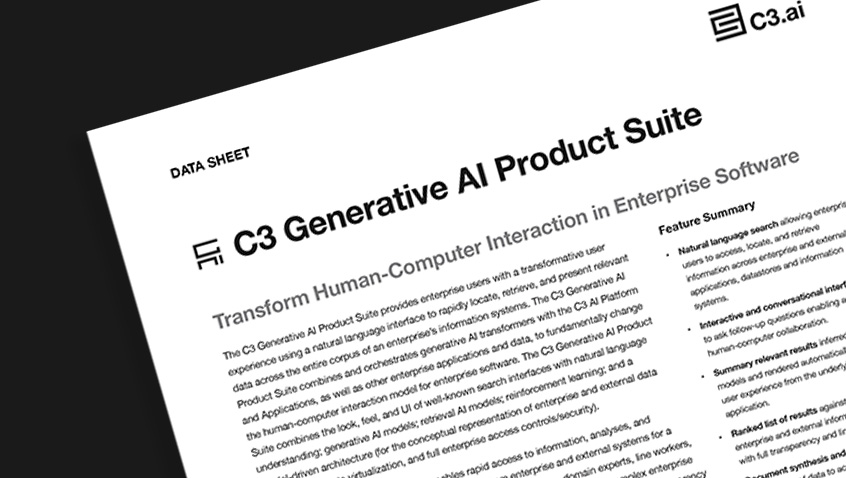- AI Software
- C3 AI Applications
- C3 AI Applications Overview
- C3 AI Anti-Money Laundering
- C3 AI Cash Management
- C3 AI Contested Logistics
- C3 AI CRM
- C3 AI Decision Advantage
- C3 AI Demand Forecasting
- C3 AI Energy Management
- C3 AI ESG
- C3 AI Health
- C3 AI Intelligence Analysis
- C3 AI Inventory Optimization
- C3 AI Process Optimization
- C3 AI Production Schedule Optimization
- C3 AI Property Appraisal
- C3 AI Readiness
- C3 AI Reliability
- C3 AI Smart Lending
- C3 AI Supply Network Risk
- C3 AI Turnaround Optimization
- C3 Generative AI Constituent Services
- C3 Law Enforcement
- C3 Agentic AI Platform
- C3 Generative AI
- Get Started with a C3 AI Pilot
- Industries
- Customers
- Events
- Resources
- Generative AI for Business
- Generative AI for Business
- C3 Generative AI: How Is It Unique?
- Reimagining the Enterprise with AI
- What To Consider When Using Generative AI
- Why Generative AI Is ‘Like the Internet Circa 1996’
- Can the Generative AI Hallucination Problem be Overcome?
- Transforming Healthcare Operations with Generative AI
- Data Avalanche to Strategic Advantage: Generative AI in Supply Chains
- Supply Chains for a Dangerous World: ‘Flexible, Resilient, Powered by AI’
- LLMs Pose Major Security Risks, Serving As ‘Attack Vectors’
- What Is Enterprise AI?
- Machine Learning
- Introduction
- What is Machine Learning?
- Tuning a Machine Learning Model
- Evaluating Model Performance
- Runtimes and Compute Requirements
- Selecting the Right AI/ML Problems
- Best Practices in Prototyping
- Best Practices in Ongoing Operations
- Building a Strong Team
- About the Author
- References
- Download eBook
- All Resources
- Publications
- Customer Viewpoints
- Blog
- Glossary
- Developer Portal
- Generative AI for Business
- News
- Company
- Contact Us
- Generative AI for Business
- Reimagining the Enterprise with AI
- What To Consider When Using Generative AI
- Why Generative AI Is ‘Like the Internet Circa 1996’
- Can the Generative AI Hallucination Problem be Overcome?
- Transforming Healthcare Operations with Generative AI
- Data Avalanche to Strategic Advantage: Generative AI in Supply Chains
- Supply Chains for a Dangerous World: ‘Flexible, Resilient, Powered by AI’
- LLMs Pose Major Security Risks, Serving As ‘Attack Vectors’
- C3 Generative AI: Getting the Most Out of Enterprise Data
- The Key to Generative AI Adoption: ‘Trusted, Reliable, Safe Answers’
- Generative AI in Healthcare: The Opportunity for Medical Device Manufacturers
- Generative AI in Healthcare: The End of Administrative Burdens for Workers
- Generative AI for the Department of Defense: The Power of Instant Insights
- C3 AI’s Generative AI Journey
- What Makes C3 Generative AI Unique
- How C3 Generative AI Is Transforming Businesses
Generative AI and the Future of Business

Why Is Generative AI Transformational for the Enterprise?
The ability for generative AI to create high-quality, contextually relevant content—text, images, videos—in a fraction of the time it takes today, is transformational for a wide swath of businesses and specific functions. Generative AI applications and use cases span practically all industries and organizations across manufacturing, healthcare, energy, retail, transportation, government, financial services, and so on.
With generative AI, marketers can rapidly create a broader set of personalized campaign content without adding more writers; financial analysts can produce granular custom reports for executives in minutes. Such advances will lead to dramatic cost savings, better customer experiences, and increase sales velocity. Those are just a few of the potential advantages.
Core to transforming a business is the positive impact generative AI can have on the enterprise search experience. Imagine using a search engine to access exactly what you need within your business, making it easy for users to access the most pertinent information, portions of reports, and predictive analytics from your enterprise data and external systems. By making data, analytics, and predictions broadly available across an organization through an intuitive search bar—and not just to the data analysts in the company— generative AI can vastly improve decision-making at every level in the organization. Suddenly, people throughout the ranks of an enterprise can take advantage of this powerful AI technology, boosting efficiency, productivity and, importantly, the ability to plan.
Take a machine operator as an example. Machinery operators typically monitor equipment performance and manufacturing conditions at a control board. They are responsible for triaging alarms, responding to urgent issues, and ensuring that operations safely and reliably meet production targets and quality specifications. It’s a demanding role. As a result, operators do not have time to read detailed manuals or aggregate information across systems to identify trends in performance. Furthermore, many manufacturers face an aging workforce, where deep expertise is leaving the organization as operators retire.
Generative AI poses a unique opportunity to overcome these challenges. A large language model (LLM) can be trained on a corpus of enterprise data – such as historical machine failures, work order logs, inspections, production performance, and OEM operating manuals – to synthesize information and make recommendations for less experienced operators.
While working directly from the control board, a machinery operator may ask a generative AI application: “The conveyor belt on production line A is broken. How do I fix it?” The Generative AI application will quickly return the exact troubleshooting steps from the equipment’s Standard Operating Procedure (SOP) document, along with additional commentary from recent work orders on the production line A conveyor belt.
With this generative AI application, lesser experienced operators instantly gain access to the knowledge and experience of the operators who came and learned before them – without requiring decades on the job. The AI application synthesizes all relevant information and makes it available in a useful and easy to grasp format, all from entering a simple prompt into the enterprise search bar. The result is an operator new to the job becomes more efficient, more effective, and can deliver better outcomes for the business.
Many business functions can benefit from applications of generative AI.
Generative AI can improve sales productivity by identifying the right opportunities to focus on; the technology can help boost conversion rates by generating personalized prospecting templates and sales scripts.
Detailed Use Cases: Generative AI can help enterprises:
- Create sales emails that are personalized and context specific. This will increase open rates and click-through rates, improving overall sales pipeline performance.
- Forecast sales and revenue by analyzing data from a variety of sources, including historical sales data, market trends, and customer behavior. This can improve accuracy of sales projections and enable better planning of marketing and sales efforts.
- Improve sales reporting by automatically summarizing notes and action items from transcribed customer interactions.
Generative AI can create personalized content for email marketing campaigns and social media posts, summarize the current state of the market, and keep competitive positioning updated with changes in the market.
Detailed Use Cases: Generative AI can help enterprises:
- Create SEO-optimized blog posts on topics relevant to a company’s target audience, improving a company’s audience engagement without significant investment.
- Create engaging and brand-compliant social media posts to improve quality and frequency, driving audience engagement.
- Generate informative web content at higher frequencies, ensuring your site stays up to date while improving a company’s website ranking in search engines.
- Perform comprehensive, accurate, and rapid market and competitive research to help inform a company’s overall positioning and go-to-market strategy.
Generative AI’s powerful capacity to leverage the latest enterprise data and predictive models will help improve manufacturing performance, increasing efficiency and throughput.
Detailed Use Cases: Generative AI can help:
- Create optimal production plans based on the latest demand picture, supply constraints, and resource availability. This will free up time for manufacturing leaders to focus on strategic aims, while also increasing manufacturing utilization, reducing production costs, and improving visibility across the manufacturing plant.
- Optimize manufacturing processes by analyzing data from sensors and other sources to create alerts about impending bottlenecks or quality issues. This can improve productivity, reduce costs, and increase the overall manufacturing yield.
- Predict operational reliability issues and assist line workers in proactively performing maintenance to prevent failures. Generative AI domain-specific models can learn from years of codified manufacturing know-how that is buried in documents and provide the most effective and precise mitigation factor that will help reduce downtime and repair costs while improving manufacturing reliability and customer satisfaction.
- Improve product quality by analyzing data from sensors, cameras, and other sources to detect defects and other issues early in the production process. This can reduce the risk of product recalls, improve customer satisfaction, and reduce the cost of warranty claims.
Generative AI has the potential to improve monitoring, analysis, and management of supply chains, revolutionizing global operations and delivering significant benefits in terms of cost savings, efficiency, and sustainability.
Detailed Use Cases: Generative AI can help enterprises:
- Identify potential suppliers by analyzing large amounts of data to identify suppliers that meet specific procurement criteria such as product availability, quality, price, and service levels.
- Improve sourcing productivity by creating RFPs, evaluating bids, creating shortlist recommendations, and drafting contracts. This will free up time for procurement professionals to focus on more strategic tasks.
- Optimize logistics operations by analyzing data such as traffic patterns, weather, and fuel prices to recommend the most efficient routes and modes of transportation.
- Assess the environmental impact of supply chain operations, allowing for assessment and reduction of carbon footprint and achievement of sustainability goals.
Generative AI can summarize the salient points of legal documents, search through large corpuses of legal documents to identify the most relevant ones, and quickly prototype new content such as patents, wills, and contracts.
Detailed Use Cases: Generative AI can help enterprises:
- Assess risk by analyzing data from a variety of sources, including financial reports, customer behavior, and market trends to identify potential risks early and take proactive mitigation measures.
- Detect fraud by analyzing transaction data and identifying patterns that are indicative of fraudulent activity. This can help companies reduce losses and prevent reputational damage.
- Ensure regulatory compliance by analyzing legal and regulatory requirements and identifying gaps in existing policies and procedures. This can help companies avoid costly fines and penalties and maintain the trust of stakeholders.
- Analyze contracts to identify potential risks and ensure compliance with relevant regulations, improving efficiency and reducing the risk of legal disputes.
- Improve cybersecurity by analyzing network traffic and identifying potential threats in real-time, helping companies prevent data breaches and other cyberattacks while maintaining the confidentiality and integrity of sensitive information.
- Monitor compliance with regulations, such as those related to environmental protection or labor standards, and avoiding costly fines and reputational damage.
- Automate reporting across any compliance and regulatory frameworks (e.g., ESG). Executives and compliance teams can delegate mundane and manual reporting tasks to generative AI models and start focusing on strategic decision making to advance the company’s performance further.
Generative AI can quickly draft reports and update content to improve and manage investor relations, automate document creation, such as invoices, purchase orders, and receipts, and identify market trends from external data sources to inform financial planning and risk management.
Detailed Use Cases: Generative AI can help enterprises:
- Automate reporting for internal controls, improve productivity of the financial analyst teams, and free up time for more strategic analysis and tasks.
- Create financial forecasts and scenarios more frequently and keep them updated as new data emerges.
- Manage contracts with suppliers, ensuring compliance with contractual obligations and reducing the risk of disputes or legal issues. This can save time and resources while improving transparency and accountability.
Generative AI can analyze employee data, such as performance and engagement, and identify opportunities to improve productivity and retention, create personalized training and development plans tailored to individual employees, and keep track of material issues within the organization.
Detailed Use Cases: Generative AI can help enterprises:
- Automate employee service tasks, such as answering frequently asked questions and resolving simple issues. This will free up time for HR professionals to focus on more complex issues.
- Create virtual assistants that help employees with a variety of tasks, such as adjusting payroll contributions, scheduling performance review sessions, or providing answers to queries for new employees. This can help businesses to provide a more convenient and personalized employee experience.
- Track employee sentiment by analyzing employee feedback and social media posts to understand how employees feel about the company’s performance and culture, identifying areas for improvement and proactively addressing employee morale.
Generative AI can create code, tests, and documentation to boost developer productivity, search across logs to facilitate forensic analysis of security and software issues, and to automate IT knowledge retrieval through self-serve generative chatbot interfaces.
Detailed Use Cases: Generative AI can help enterprises:
- Develop applications more quickly and efficiently by automating certain aspects of the development process. Generative AI models can be configured to automatically generate code, perform unit tests, identify bugs, and provide other developer co-pilot features to significantly reduce application development timelines and improve the overall quality of those applications.
- Automate IT support, from answering frequently asked questions to resolving simple issues, freeing up IT professionals to focus on more complex issues.
- Improve IT security by detecting and preventing cyberattacks. This will help businesses to protect their data and systems from unauthorized access.
- Manage IT assets by tracking the location and usage of devices, helping businesses improve efficiency, reduce costs, and avoid costly cybersecurity risks.
- Manage IT projects by scheduling tasks and tracking progress, helping businesses complete projects on time and within budget.
- Optimize network performance by analyzing data from sensors, servers, and other sources to identify potential bottlenecks and proactively address them. This can improve network uptime and reduce the risk of downtime.
- Improve cybersecurity by analyzing network traffic and identifying potential threats in real-time. This can help companies prevent data breaches and other cyber-attacks.



